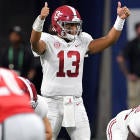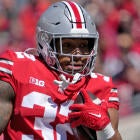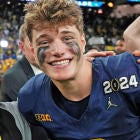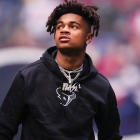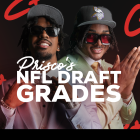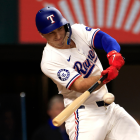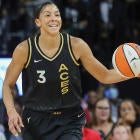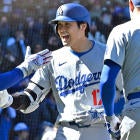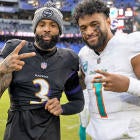Next year's quarterback draft class is all about Tua Tagovailoa and Justin Herbert, but for as many positives as they've shown in their collegiate careers to date, they have some kinks to work out in their final seasons at Alabama and Oregon respectively.
Georgia's Jake Fromm has first-round potential too, and Stanford's K.J. Costello is a big-armed starter to monitor.
Below I'll take a specific look at the flaws those top quarterback prospects need to fix to ease the minds of scouts before the 2020 draft.
Tua Tagovailoa, Alabama
Must improve: Arm strength and downfield ball placement
Tagovailoa had the highest Passing Efficiency Rating (199.4) in Division I history in 2018, bettering two of Baker Mayfield's seasons at Oklahoma and Kyler Murray's Heisman-winning campaign.
Despite Tagovailoa's marvelous work as a passer and strong likelihood of being a top 10 pick, he does have minor issues to work out of his game to improve as a prospect and ultimately become a star in the NFL.
The first noticeable ding on Tagovailoa's game is his lack of a big arm. Having a cannon isn't a prerequisite for being an effective pro quarterback, but not possessing one can get passers into trouble in some instances on Sundays.
His smaller frame likely doesn't help when needing to create a lot of momentum in his arm, but it's Tagovailoa's off-kilter front foot that forces him to use too much of his upper body and not enough of his lower body to generate velocity. He has a tendency to step a shade too far to the outside of the direction of his intended target. Therefore, the power from the torquing of his body improperly transfers outward instead of forward, his hips open early, and those throws are made almost entirely with his arm. This happens the most often on throws to his right.
Tagovailoa must fine-tune his footwork -- especially where that front leg lands in relation to where he's throwing the ball -- to produce more speed on his passes.
Secondly, his downfield accuracy could use some polish. Yes, every Tagovailoa highlight reel from 2018 includes a variety of long balls to Jerry Jeudy, Henry Ruggs, and Devonta Smith. But many of those tosses were to wide open receivers. Too often, when Tagovailoa needed to fit the ball through a tight window deep, his passes simply weren't on the money.
According to Sports Info Solutions, Tagovailoa was "on target" on 64.8 percent of his throws made 20 or more yards downfield, a figure that seems high but was actually the 23rd-best among college quarterbacks last season. That figure was behind Kyler Murray (70.1 percent, 5th place), Drew Lock (67.8, 9th place), Will Grier (67.6, 10th place), and a tenth of a percentage point behind Dwayne Haskins (64.9).
Tagovailoa works very well within the pocket when pressure is mounting, can make anticipation throws, flies through his progressions, and has pinpoint accuracy at the short-to-intermediate levels. His arm strength and deep-ball accuracy must improve.
Justin Herbert, Oregon
Must improve: Pocket poise consistency, downfield accuracy
Last year, we ran this exact same article, Herbert was on the list, and I deemed his pocket drifting as the element of his game that needed to improve. As a junior in 2018, he did just that. It's gotten to the point where stepping up into the pocket looks seemingly natural to Herbert, a vital quarterbacking attribute.
And, Herbert demonstrated the ability to move laterally away from pressure last season. But, now, a catch 22 of sorts exists in his pocket presence. Because of he's so dynamic throwing on the run, Herbert resorts to it too often.
So, while Herbert put an array of outstanding on-the-run-throws on film, a lot of them came after panicked or rushed departures from the pocket at the first sign of pressure. Herbert's blend of athleticism, vision, and touch to consistently drop dimes on the run is rare, but leaning on that part of his game isn't sustainable at the next level.
Playing quarterback in the NFL is difficult enough. You can't make it more difficult on yourself. And like every quarterback on Earth, Herbert is most effective as a passer standing upright with a balanced base from inside the pocket.
Pocket patience -- or what I'll occasionally refer to as the Brady Trait because Tom Brady is the master at waiting inside the pocket -- isn't mentioned enough in quarterback analysis. Spilling out toward the either sideline incrementally narrows the field with each step made by the quarterback and shortens the play for the offense.
Herbert proved he can be patient inside the pocket in 2018. He just needs to do it more often in 2019.
Secondarily, Herbert's downfield accuracy needs to improve slightly, although I saw better ball placement on deep balls from him as a junior than the numbers would suggest. Per SIS, he was "on target" on 55.4 percent of his throws made 20 or more yards down the field last year, the 77th-best rate in the nation. However, he attempted 74 of those throws altogether, the seventh-most in college football and had the second-best on-target percentage of the quarterbacks in the top 10 of those attempts.
So despite the lower on-target percentage, Herbert put a plethora of awesome downfield bucket throws on film last year. But I wouldn't call him outstandingly accurate when stretching the field.
Jake Fromm, Georgia
Must improve: Ball placement, decision-making, and play under pressure
In a few important ways, Fromm plays well beyond his years. He already possesses the ability to make anticipation throw, and his patience inside the pocket is tremendous for a 20-year-old starter.
And in his two seasons under center at Georgia, Fromm's been the epitome of a rhythm passer. When in rhythm, he's surgical, especially in the quick passing games and toward the sidelines at the intermediate levels. However, there are stretches when he simply doesn't look very comfortable, and it leads to wayward ball placement. Most of the passes when he's operating in that state are completed but are often low or outside the ideal location, which force his receivers to make acrobatic catches or hinder yards-after-the-catch opportunities. He hasn't been very accurate down the field thus far in his collegiate career either.
Also, despite Fromm's passing figures improving across the board in 2018 from their 2017 levels, I noticed him putting the ball into harm's way or trying to fit throws through exceptionally tight windows too often last year. Because he's such a methodical passer and doesn't have a huge arm, a super-aggressive tendency is concerning.
Georgia's overpowering offensive line has kept Fromm relatively clean over the past two seasons. While he flashed some pocket-drifting skills, Fromm looks unsure as to how he should move away from pressure, and his questionable decision-making is accentuated under duress, thereby creating more opportunities for the defense to make a big play. Off-balance, late throws and passes across his body are common in those instances. He has enough athleticism to make oncoming defenders miss, but his pocket presence does not consist of refined, seemingly automatic movements at this point.
According to SIS, Fromm was on target on 56.1 percent of his passes under pressure in 2018, the 87th-best rate among quarterbacks at the FBS level.
He lost center Lamont Gaillard to the NFL as well as receivers Mecole Hardman, Riley Ridley, and Terry Godwin and tight end Isaac Nauta. Although the Bulldogs are bound to be one of the most dominant rushing teams in college football again in 2019, Fromm himself will have to carry the offense much more than he did in either of his first two years in Athens. Improving his ball placement, decision-making, and play under pressure will benefit Georgia a great deal and make a significant positive impact his draft stock.
K.J. Costello, Stanford
Must improve: Speed through his reads, holding the ball too long
Costello is a big, 6-foot-5 quarterback with a Patrick Mahomes-like whip motion that generates major velocity. His specific skill set and ultra-aggressive style is perfect in Stanford's vertical-based passing game that places much responsibility on its receivers and tight ends to make contested catches.
In his second season as Stanford's starter, Costello improved his completion percentage from 58.8 to 65.1 and his yards-per-attempt average from 7.6 to 8.5 while throwing 29 touchdowns and 11 interceptions.
Per SIS, he was deemed on target on 63.1 of his throws made 20 or more yards down the field, good for the 30th-best on-target percentage on those deep passes at the FBS level. Sure, his talented pass-catchers likely helped him in some of those occasions, but Costello ripped a copious amount of dimes downfield last season.
As for his flaws, they're decently common among young, relatively inexperienced passers. Costello is mostly a one-read passer. He locks on, sometimes too long, and lets it rip. He flashed the ability to move through his reads, but it's not anywhere close to being a consistent aspect of his game. It allows defenders to close on comeback routes and throws at the short-to-intermediate level.
Another byproduct of Costello slowly moving through his progressions -- if at all -- he takes plenty of hits. Too many. While he's demonstrated toughness by repeatedly getting up, taking big hits from defensive linemen and blitzing linebackers on a regular basis is not sustainable at the NFL level.
Costello lost rebounding extraordinaire JJ Arcega-Whiteside and matchup nightmare Kaden Smith to the NFL, but the Cardinal as always, return large, physical pass catchers with plus ball skills this season. So his arm talent, aggressiveness, and impressive downfield ball placement will certainly be on display once again in 2019.
However, Costello's eyes have to get faster. If his first read isn't there, he needs to look to his second option, and then maybe his third. Coaches might love to see him pop back up after taking shots inside the pocket, but the fewer of those hits he endures as a senior, the better.
So, which QBs will be first-round picks?
It'd take a colossal meltdown for Tagovailoa to not land in Round 1 in the 2020 Draft. We're surely in for some questioning his lack of traditional height and arm strength during the pre-draft process. But his accuracy, full-field reading, and NFL veteran-like ability to make anticipation throws that led to his record-breaking passing efficiency season in 2018 will almost assuredly produce another monstrous season in Tuscaloosa. After that, Tagovailoa should get serious No. 1 overall pick buzz.
The same is mostly true for Herbert. He'd have to regress from his junior year figures to be picked after selection No. 32 next year. He's just too tall, too athletic, with too live of an arm, with too many dazzling throws on film already to not go in the first round. And he's playing in front of a Kevlar offensive line as a senior. It might not be popular right now, but I think Herbert has just as good of a chance as Tagovailoa to be the first player picked in the draft.
Fromm has a good chance to go in the first round. He's not a lock. To solidify himself in that mid-to-late Round 1 range, he needs to prove to be capable of carrying Georgia's offense more than he did in 2018. Fromm is a solid prospect right now, he's just not as accurate as Tagovailoa nor as physically gifted as Herbert.
Costello's a sleeper who seems pretty safe at the same time. A get-it-out-quickly West Coast offensive coordinator isn't going to love him. But a coach who wants to push it down the field often could easily get very enamored with Costello because of his size, impressive arm, and fearless nature. Due to the noticeable rawness to his game, he seems like a second-or third-round pick at this point.












